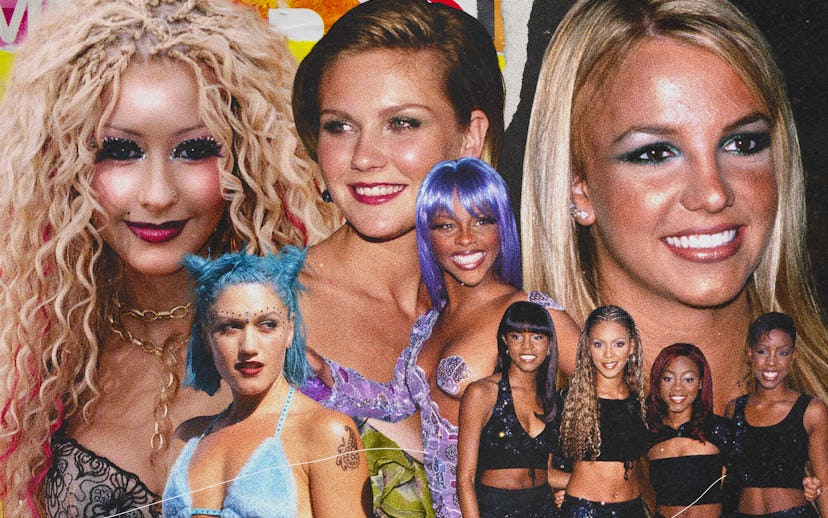
Beauty
Y2K Beauty Is The Bright Spot In The 2000s Revival
Writer Amber Rambharose reflects on her complicated feelings about the resurgence of early aughts beauty and fashion trends.
I was a preteen in the early aughts — ten when the internet was supposedly going to collapse, and 13 when Mean Girls hit theaters. Far too young to hate my body, I hated it all the same because it was brown, and after puberty, round in places the women in teen movies and on magazine covers were not. I had bigger breasts in 8th grade than 30-year-old Jennifer Garner did in 13 Going on 30 — than most teen celebrities did, in fact. I couldn’t see any of my bones when I stood naked in front of the mirror and this troubled me, since the body standards at the time were decidedly slim-hipped, boyish, flat-chested, flat-stomached, and flat-bottomed — the better to slip into your low-rise jeans with, I can only assume.
Suffice it to say, I personally am not delighted to hear these fashion trends are making a comeback. What I am excited about, however, is body glitter all over everything, and on all skin tones. And that’s what’s tricky about Y2K fashion and beauty: it’s half whimsy, manic-pixie-fairy-dust, shimmer body glitter you can eat, and half celebratory of a thinness and whiteness that is shocking to me now.
Y2K trends, much like the first IT miniseries, need a reboot. The late nineties and early aughts pop culture scene was overwhelmingly white, and nowhere was this as evident as the beauty trends that were made popular at the time. As a young teen, everything I loved about Y2K beauty was featured prominently on the white pop stars and starlets of the era: Kirsten Dunst on the red carpet for Bring It On, awash in bright color and lots of shine; Christina Aguilera doused in shimmer at any given event; Britney Spears and Gwen Stefani in glittery lids, highlighter you could bounce a camera flash off of, and bright washes of hot pinks and baby blues. These were the aspirational beauty looks you saw on the darlings of MTV and teen movies. But revisit a red carpet roundup from that time, and it’s hard to find a woman of color in the same colorful makeup aesthetic — wearing a shimmery lid in any color other than gold, or a glossy lip that isn’t in tones of brick or mauve. (Lil’ Kim was an exception, when she debuted her iconic lilac-highlighted lip at the 1999 MTV VMAs.)
That’s not to say Black celebs in the ‘90s weren’t stunning. They glowed and gleamed, softly diffused, looking not underdone, but also not transformed because, of course, they couldn’t be — makeup wasn’t yet being made for them. Circa Y2K, I didn’t want to glow like Gabrielle Union or Aaliyah or Beyoncé — I wanted to f*cking sparkle. So, it’s refreshing to scroll through the behind-the-scenes images from Spring 2022 Fashion Week in Paris and Milan and see these trends I longed to replicate as a preteen finally being worn by people who look like me. The fashion trends, however, are a different story.
One of the reasons I first dove into beauty, not fashion, is because I spent my first internship in a fashion closet for a very chic magazine, and everyone I worked under seemed miserable. Fashion was torment (at least that’s how it seemed), whereas beauty was fun. Beauty left more space for individuals to be individual, and while times are changing in the fashion industry, beauty has always seemed a safer space to me — a space for more experimentation and self-expression. Case in point: I am never, ever, ever getting back together with the ultra low-rise denim trend, nor the kind of disordered eating habits I maintained to wear them in public. I will not be showing off my abs (because I do not have visible abs) or my pelvic bone, because my bones are nestled firmly under my skin.
This is, apparently, a shame because the fashion trends coming out of the Spring 2021 runways remind me a lot of what was so traumatizing to me about the Y2K era. “Pelvic bone” as a trend and micro-mini skirts being marched down the runways at Miu Miu — these trends again seem to confirm the belief that there is only one celebrated body type, and that body type does not resemble mine (or that of most women). The body glitter and rhinestones appliques, though, I will gladly take.
The feeling of seeing these Y2K trends — both the beloved and the unfortunate —on the runways and in my Instagram feed is probably familiar to many Millennials: a rush of nostalgia and a little bit of middle school horror. I love that the bright beauty trends of my youth are being replicated on all types of folks, yet I am terrified that the next generation is going to subject themselves to what I did in pursuit of a Kiera Knightly torso. That said, maybe it’ll be different this time around, as recycled trends often are. The latest generation of TikTok stars cut their teeth on body positivity. The starlets of yore have grown up and gone to rehab, their celebrity status diminished by the social media golden age. Beyoncé isn’t a size two anymore and she’s not just softly golden — she, too, glitters. I can’t remember the last time a major beauty trend relied on a certain skin tone, let alone a certain hair type, which gives me hope that the Y2K craze will flourish, while leaving its more sinister elements behind.
I’m ready for Y2K beauty to be back in full swing, butterfly clips and all, embraced by all skin tones and hair types. The body standards and homogeneousness of that era, however, can stay firmly where they belong: in the past.
This article was originally published on